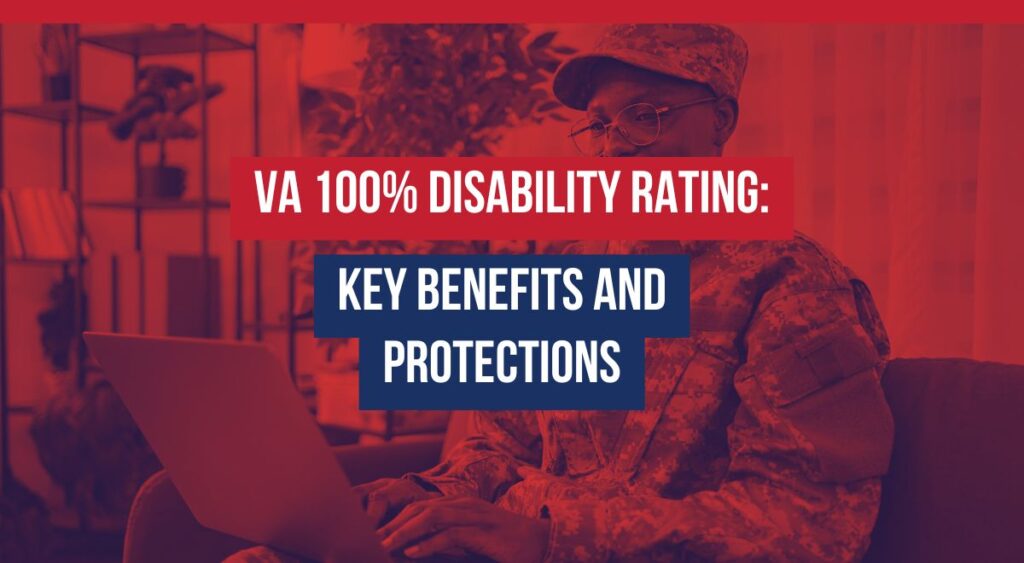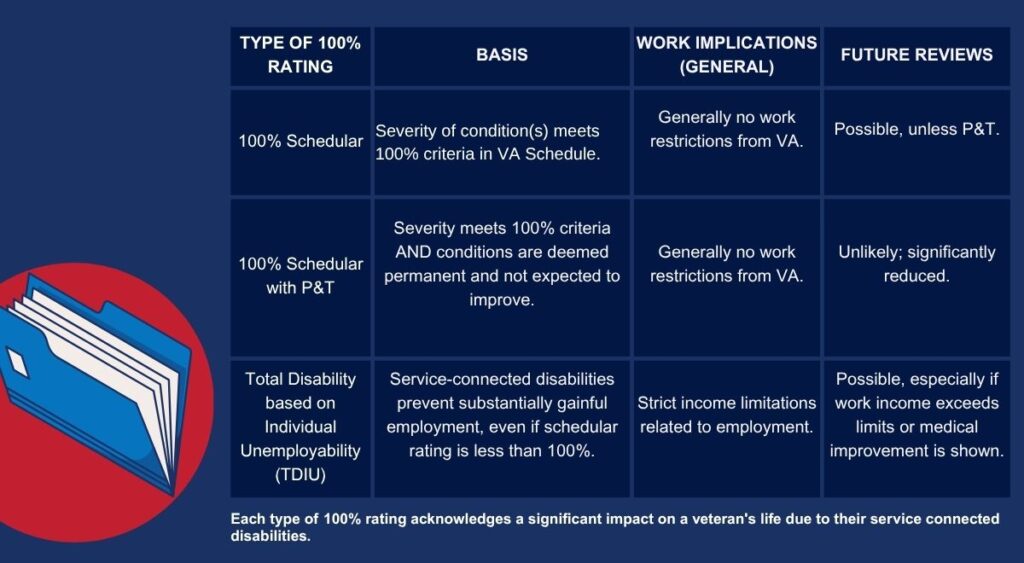
Receiving a 100% disability rating from the VA is a significant acknowledgment for any veteran. It signifies that the Department of Veterans Affairs recognizes your service-connected conditions profoundly affect your life. This article provides critical information about the VA 100% Disability Rating: What It Really Means Details full benefits working options and protections, helping you access all the support you have earned through your military service.
Understanding Your VA 100% Disability Rating
The Department of Veterans Affairs (VA) employs a rating system to determine the severity of a veteran’s service-connected disabilities. These ratings span from 0% to 100%, where a 0% rating usually means a condition is recognized as service-connected but isn’t currently severe enough for monthly compensation. A 100% VA disability rating, however, indicates the VA considers you to have a total disability.
This total disability status can arise from a single severe condition. Alternatively, it can be a combined rating derived from multiple conditions using “VA math,” a specific formula that differs from simple addition. Understanding how VA math works is helpful, as multiple lower ratings do not always add up as one might expect.
Therefore, a 100% rating acknowledges substantial limitations resulting from your military service. This VA disability rating opens pathways to numerous important veterans benefits. Knowing the basis of your 100% rating is vital, as it can influence specific aspects discussed later.

The Core Components: VA 100% Disability Rating: What It Really Means Details full benefits working options and protections.
Let’s explore this important topic more thoroughly. Specific knowledge allows you to make well-informed decisions concerning your VA benefit. This information pertains to your well-being and future stability for you and potentially your surviving spouse.
Unpacking the “What It Really Means” Part
A 100% VA disability rating is more than just a figure; it reflects varied situations. How an individual veteran achieves this 100% status influences aspects such as future reviews and, in some cases, work options. Let’s examine the primary ways veterans obtain this rating.
First, there is the 100% schedular rating. This indicates that one or more of your service-connected disabilities meets the 100% criteria detailed in the VA’s Schedule for Rating Disabilities. This could be a single condition, such as certain severe heart conditions or mental health conditions, rated at 100% on its own; for many war veterans, these conditions are a direct result of their experiences. Alternatively, multiple conditions can combine to 100% using the VA’s specific calculation formula.
Next is Permanent and Total (P&T) status, a significant addition to a 100% rating. P&T signifies the VA believes your disabilities are not expected to improve. Veterans with a P&T status typically face fewer future medical re-evaluations from the VA, offering considerable stability and peace of mind. While not all 100% ratings are automatically P&T, many are, particularly for long-standing or obviously static disabilities.
Finally, there is Total Disability based on Individual Unemployability (TDIU). This path is available for veterans who do not possess a 100% schedular rating but whose service-connected disabilities prevent them from securing and maintaining substantially gainful employment. If you are granted TDIU, the VA compensates you at the 100% disability rate, recognizing your individual unemployability. However, TDIU includes specific regulations regarding work, which will be detailed later.
Here’s a simple table outlining these paths:

A Deep Look at the Full Benefits
A 100% VA disability rating grants access to an extensive array of disabled veterans benefits for you and often your family. These benefits are structured to aid with financial stability, health care, and overall quality of life. Being aware of your entitlements is crucial for maximizing this support.
The most immediate VA benefit is the monthly disability compensation. This tax-free payment is designed to offset lost earning capacity stemming from your service-connected disabilities. The exact amount of this monthly compensation varies based on whether you have dependents, and current VA disability compensation rates are available on the VA’s website; these benefit rates are typically adjusted annually for cost of living.
Comprehensive health care is another cornerstone benefit. You generally receive care for all medical conditions, not just those service-connected, through the VA health system with minimal or no copayments. Eligible family members, including a surviving spouse, might also qualify for health care via the Civilian Health and Medical Program of the Department of Veterans Affairs (CHAMPVA), especially if you hold a 100% P&T rating. This comprehensive coverage includes essential dental care, vision services, and mental health services, which are vital for many veterans.
Education benefits for your dependents become significantly more accessible. The Dependents’ Educational Assistance (DEA) program, also known as Chapter 35 benefits, provides financial aid for school or job training to eligible spouses and children of veterans with a 100% P&T rating or those who died as a result of service. This dependent assistance can profoundly impact your family’s educational and career opportunities through various education programs and degree programs.
Many states offer substantial property tax exemptions for 100% disabled veterans. These exemptions can lead to significant annual savings on local property taxes. Since these benefits vary considerably, you must check with your specific state or county veteran service office or revenue department.
The VA provides travel allowances for medical appointments. This means you can receive assistance with the costs of traveling to and from your VA medical appointments or VA-approved non-VA care. This can include mileage reimbursement and, in some cases, meals and lodging if you meet specific criteria, easing the burden of accessing necessary health care.
You and your eligible family members may also gain base privileges. These exchange privileges include access to shop at military commissaries and exchanges (such as AAFES or NEX). You might also be able to use certain Morale, Welfare, and Recreation (MWR) facilities, offering savings and access to goods and services typically reserved for active duty personnel.
Federal hiring preferences are extended to disabled veterans, and a 100% rating can provide a notable advantage when applying for government jobs. This federal hiring preference acknowledges your service and sacrifice. Many private employers also actively seek to hire veterans, valuing their skills and experience.

The Veteran Readiness and Employment (VR&E) program, formerly Vocational Rehabilitation and Employment, can also be a valuable resource. Even with a 100% rating, you might wish to work if you are able. VR&E offers counseling, training, and job placement assistance; this service program is designed to support veteran readiness for the workforce. If you cannot work, VR&E may provide services to help you live as independently as possible, contributing to economic development for the veteran community.
Life insurance options become more readily available. Veterans with a 100% rating may be eligible for Service-Disabled Veterans Life Insurance (S-DVI). There are specific deadlines for applying after receiving your rating, so investigating this life insurance benefit promptly is advisable. S-DVI offers policies up to a certain amount, with options for supplemental coverage in some instances.
The VA offers certain burial and plot allowances to help cover funeral and burial costs. These benefits help alleviate the financial burden on families during a challenging time. Spouses and dependents may also be eligible for burial in a VA national cemetery, alongside their veteran.
Some veterans might qualify for Special Monthly Compensation (SMC). This is an additional tax-free benefit paid to veterans who, as a result of military service, incurred the loss or loss of use of specific organs or extremities, or have other specific needs. SMC is paid in addition to regular VA disability compensation and often applies to those with particularly severe disabilities even beyond a standard 100% rating.
Ancillary benefits may also be available. These could include grants for Specially Adapted Housing (SAH) to build or modify a home to be more accessible for disabilities. Alternatively, an auto grant might help purchase a specially equipped vehicle if certain service-connected disability criteria related to mobility are met. These are for specific circumstances but are incredibly valuable.
Do not overlook state-specific veterans benefits. Beyond property tax breaks, many states offer perks like reduced fees for hunting and fishing licenses, free or reduced-price state park passes, or educational aid for dependents through state-level education programs. Each state’s offerings are different, so contacting your local veteran service office or using an online school locator for educational opportunities is a smart step. The VA also offers support for women veterans and minority veterans, including Native American veterans, through specialized programs and outreach.
For those seeking further education or training, various avenues are supported. Options include non-college degree programs, flight training, entrepreneurship training, correspondence training, and co-op training. Assistance may also be available for national tests, certification tests, and prep courses, with possibilities for tuition assistance, tutorial assistance, and even accelerated payments under programs like the Montgomery GI Bill or Vet Tec. This robust support system aims to foster higher learning and skill development.
Exploring Your Working Options
A frequent question among American veterans is whether they can work with a 100% VA disability rating. The answer generally hinges on the specific basis for that 100% rating. This distinction is critical because it directly influences your capacity to earn income without jeopardizing your veterans benefits.

If you possess a 100% schedular rating, whether for a single condition or combined conditions, you can typically work without any VA-imposed restrictions. The VA has assessed your disability level based on its schedule of ratings. Your work activity usually does not affect this type of rating, provided your medical condition remains unchanged.
The same generally holds true if your 100% schedular rating is also designated as Permanent and Total (P&T). The P&T designation pertains to the VA’s assessment of your condition’s stability, not your employment status. Thus, you can generally work with a 100% P&T rating, and your earnings would not be a factor in maintaining this schedular rating.
However, the regulations are markedly different if you are rated 100% disabling due to Total Disability based on Individual Unemployability (TDIU). TDIU is specifically granted to veterans whose service-connected conditions prevent them from maintaining what the VA defines as “substantially gainful employment.” Consequently, there are strict limitations on earned income if you receive TDIU benefits. Exceeding these income thresholds, which are generally tied to the poverty level for one person, can result in the VA reviewing and potentially discontinuing your TDIU status, as it would suggest you are, in fact, capable of substantially gainful employment.
Understanding Your Protections
Once you receive a VA disability rating, particularly a high one like 100%, you might be concerned about it being reduced in the future. The VA does have procedures for re-evaluating ratings. However, several protections are in place for veterans, especially for long-standing or very severe disabilities resulting from their active duty.
The VA has established specific rules that make it more difficult to reduce established ratings. For instance, a rating that has been in effect for 5 years or more is considered “stabilized,” and the VA must demonstrate sustained improvement in your condition to reduce it. If your rating has been continuous for 10 years or more, the VA cannot sever service connection unless fraud is proven, though they can still reduce the rating if your condition demonstrably improves. A rating held for 20 years or more at the same level is generally protected from reduction below that level, except in cases of fraud. Furthermore, veterans over age 55 are typically not subject to routine future examinations unless there is clear evidence of improvement or error in the previous decision.
Re-evaluations, often called Routine Future Examinations (RFEs), are the VA’s method for checking if a disability has improved. If your condition is deemed P&T, you generally will not be scheduled for future exams related to that condition. For ratings not designated P&T, the VA might schedule an exam a few years after your rating is granted or if new medical evidence suggests your condition may have improved. Attending these exams is mandatory; failure to do so can lead to a proposal to reduce or terminate your VA disability compensation.
Having a Permanent and Total (P&T) status provides significant stability regarding your VA benefits. As previously noted, P&T means the VA considers your 100% disability unlikely to improve. This status considerably lessens the likelihood of future re-evaluations. It also qualifies you and your family for additional benefits like CHAMPVA health care and DEA educational assistance for your dependents. While not an absolute shield against any future review, P&T offers the most security for your 100% rating.

Navigating Potential Challenges and Next Steps
Even after securing a rating, you might encounter some challenges or need to undertake further actions. Understanding how to manage these situations can simplify the process. Remaining proactive in managing your VA claim and benefits is always advantageous.
Sometimes, the VA’s rating decision might not seem accurate. You might believe your disability is more severe than the rating indicates, or a condition was improperly denied service connection. If you disagree with a VA decision, you have the right to appeal. The VA’s decision review process offers several options: Supplemental Claims (if you have new and relevant evidence for your VA claims), Higher-Level Reviews (a review by a more senior adjudicator), or Board Appeals (an appeal to the Board of Veterans’ Appeals). Filing a fully developed claim or submitting fully developed claims initially can sometimes expedite the process by providing all necessary evidence upfront. There are specific deadlines for filing these, so acting promptly and potentially filling out the correct VA form is crucial if you are considering an appeal.
It is very important to keep your information updated with the VA. This includes your current address, contact information, and bank details for direct deposit of your monthly compensation. Also, promptly report any changes in dependent status (such as marriage, divorce, or the birth of a child), as this can affect your compensation amount and month eligibility for certain benefits. Keeping the VA informed helps ensure you receive your benefits without interruption and get important communications; the VA may use social media or other channels for general announcements, but personal correspondence is key.
Conclusion
A 100% VA disability rating represents a formal acknowledgment of the profound ways your service-connected conditions impact your life. It is a gateway to vital support, including financial assistance and comprehensive health care. By thoroughly understanding your VA 100% Disability Rating: What It Really Means Details full benefits working options and protections, you empower yourself. This knowledge allows you to better utilize the benefits you have honorably earned through your military service, comprehend your work possibilities, and be aware of the protections afforded to your rating. This understanding truly assists you and your family in planning for a more secure and stable future.

